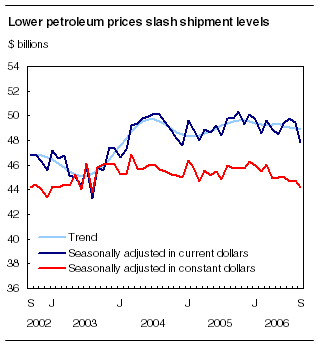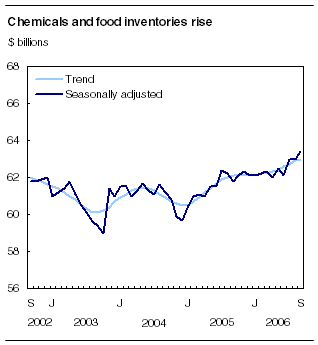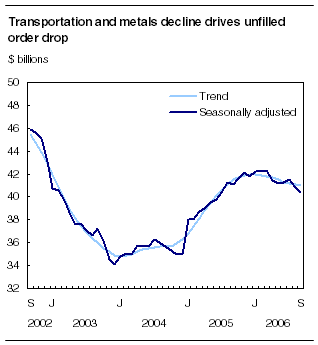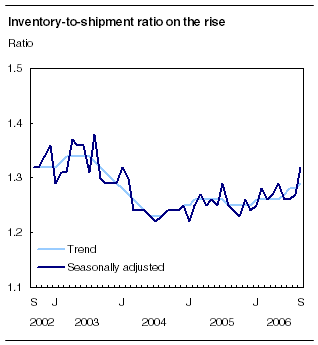Common menu bar links
Monthly Survey of Manufacturing
Archived Content
Information identified as archived is provided for reference, research or recordkeeping purposes. It is not subject to the Government of Canada Web Standards and has not been altered or updated since it was archived. Please "contact us" to request a format other than those available.

Shipments from Canadian factories declined to their lowest level in nearly two years in September, in part the result of sluggish activity in the transportation sector and lower prices for petroleum and coal products.
Canadian manufacturers shipped goods worth $47.9 billion, down 3.3% from August and the lowest level since December 2004. It was the second monthly decline in a row and the fastest rate of decline in shipments since August 2003.
After taking price fluctuations into account, the value of shipments was down just 1.2% to $44.1 billion, after levelling off in August. This indicates that most of September's decline in shipment value was due to lower prices.

On a year-to-date basis, the volume of shipments fell 1.0% between January and September this year, compared with the same period last year.
Shipments were off in 13 of 21 manufacturing industries and 3 were unchanged in September. Durable goods shipments tumbled 2.5% to $25.6 billion in the wake of the transportation sector's third monthly decrease in a row, and sixth in the last nine months.
Revisions and seasonal adjustmentMonthly, preliminary estimates are provided for the reference month with revised estimates, based on late responses, for the previous three months. Non-durable goods industries include food, beverage and tobacco products, textile mills, textile product mills, clothing, leather and allied products, paper, printing and related support activities, petroleum and coal products, chemicals, and plastics and rubber products. Durable goods industries include wood products, non-metallic mineral products, primary metals, fabricated metal products, machinery, computer and electronic products, electrical equipment, appliances and components, transportation equipment, furniture and related products and miscellaneous manufacturing. Unfilled orders are a stock of orders that will contribute to future shipments assuming that the orders are not cancelled. New orders are those received whether shipped in the current month or not. They are measured as the sum of shipments for the current month plus the change in unfilled orders. Some people interpret new orders as orders that will lead to future demand. This is inappropriate since the "new orders" variable includes orders that have already been shipped. Readers should note that the month-to-month change in new orders may be volatile. This will happen particularly if the previous month's change in unfilled orders is closely related to the current month's change. Not all orders will be translated into Canadian factory shipments because portions of large contracts can be subcontracted out to manufacturers in other countries. Also, some orders may be cancelled. |
Non-durable goods suffered from declining commodity prices in September as shipments fell 4.2% to $22.2 billion. The price of petroleum and coal products plunged 13.8%, their largest monthly price decline in over three years.
The transportation sector's problems did not stop with shipments. Total transportation inventories were up in September, and while new orders in the sector rose slightly, the motor vehicle industry dropped considerably.
Shipments fall on lower petroleum prices and transportation equipment output
Oil prices declined earlier than usual in September, largely due to strong inventory levels in the United States for gasoline and crude oil, and the prices continued to decline as inventories accumulated.
Canadian refineries continued to produce at slightly lower than capacity, but when combined with a price drop of 13.8%, shipments fell 15.3% to $4.7 billion.
Transportation equipment fell 2.9% to $8.9 billion, the third month of decline. September was a tense month for the motor vehicle assembly industry facing the possibility of the moth-balling of excess capacity in North America.
In spite of a relatively strong month of sales on both sides of the border, shipments in the motor vehicle industry fell 8.5% to $4.5 billion, as manufacturers drew down their finished goods inventories by 12.2% to fill customer orders. Shipments for auto parts suppliers fell 4.5% to $2.2 billion in the wake of the auto assembly slowdown.
Aerospace was the good-news industry in the transportation equipment sector through September, with shipments rising 18.1% to $1.3 billion on strong quarter-end deliveries. Due to the high value of goods produced by the aerospace industry, monthly swings of plus or minus hundreds of million dollars are not unusual. For the first nine months of 2006, aerospace shipments are 3.6% lower compared with the same period of last year.
Machinery manufacturing shipments fell 6.2% to $2.5 billion. The two-month decline of 8.5% has pushed this industry to its lowest level in 14 months.
Food manufacturing, the lone bright spot, was no match for widespread declines and tepid gains in all other sectors. Food shipments increased 2.0% to $5.8 billion. Canadian food processors shipped a billion dollars of product more than their counterparts in the petroleum and coal industry, the first time this has happened since oil prices began to take off in February of this year.
Shipments drop in seven provinces
British Columbia and Prince Edward Island posted small increases while shipments in Quebec were unchanged. Shipments fell in every other province in September — especially those provinces with a significant presence in the petroleum and coal industry. Shipment decreases in Nova Scotia, New Brunswick, Ontario and Alberta can be directly attributed to the falling value in petroleum products.
In Quebec, strong gains in the aerospace industry offset declines in oil refining, chemicals and the beverage and tobacco industries. Quebec shipments remained at $11.7 billion.
Manufacturing in Ontario lost ground in 16 of 21 industries, with the largest decline being more than half a billion dollars in the transportation equipment industry. Most of it was in motor vehicle manufacturing, which posted a 8.2% decline to $4.5 billion. The value of petroleum refining fell by 17.0% to $1.4 billion. Widespread declines included machinery (down 8.8% to $1.2 billion) and fabricated metals (down 8.1% to $1.3 billion).
A strong early harvest in Ontario pushed food industry shipments up 2.7% to a record high $2.4 billion.
Weaker oil prices were the main factor in the 5.0% decline in Alberta's manufacturing shipments — the largest monthly decline in more than three years. Shipments of petroleum and coal products fell 17.2% to $1.1 billion in September.
Shipments from British Columbia increased 0.2% to $3.5 billion. In spite of a 5.8% decrease in paper shipments to under a half billion dollars, increased shipments of food and fabricated metals offset the decline. Wood products remained British Columbia's number one industry, increasing by 1.2% to nearly three-quarters of a billion dollars.
| Manufacturing shipments, provinces and territories | |||||||
|---|---|---|---|---|---|---|---|
| August 2006r | September 2006p | August to September 2006 | |||||
| Seasonally adjusted | |||||||
| $ millions | % change | ||||||
| Canada | 49,474 | 47,852 | -3.3 | ||||
| Newfoundland and Labrador | 169 | 168 | -0.1 | ||||
| Prince Edward Island | 106 | 106 | 0.1 | ||||
| Nova Scotia | 779 | 731 | -6.1 | ||||
| New Brunswick | 1,273 | 1,153 | -9.4 | ||||
| Quebec | 11,681 | 11,685 | 0.0 | ||||
| Ontario | 24,248 | 23,121 | -4.6 | ||||
| Manitoba | 1,181 | 1,160 | -1.7 | ||||
| Saskatchewan | 859 | 823 | -4.2 | ||||
| Alberta | 5,646 | 5,364 | -5.0 | ||||
| British Columbia | 3,526 | 3,532 | 0.2 | ||||
| Yukon | 2 | 2 | 13.7 | ||||
| Northwest Territories including Nunavut | 6 | 6 | 16.2 | ||||
| |||||||
Food and chemical products inventories lead inventory increase
Total inventories for manufacturers increased 0.6% to $63.4 billion in September, the third increase in a row. It was propelled by food inventories, which increased 3.4% to $5.2 billion, the ninth monthly increase in the last year and the highest inventory level since April 2004. Chemical inventories also increased for the 12th consecutive month to record levels, up 0.9% to $7.1 billion. Primary metals increased 1.9% to $6.6 billion.
Transportation equipment inventories increased 0.8% to $8.7 billion after falling 1.4% in August. The gain was concentrated in the automotive industry. Auto manufacturing inventories of goods in process and raw materials offset the decline of finished goods, resulting in total inventories climbing by 4.9% to $1.4 billion. Meanwhile, auto parts inventories rose 2.6% to $1.5 billion.
Aerospace inventories declined 1.2% to $3.9 billion on strong shipments of finished goods.
Wood products inventories decreased 1.7% to $4.6 billion, resulting from lower demand for housing in the United States and reduced logging activity.
Inventory in raw materials fell marginally while finished products and goods in process inventories increased in September.

Motor vehicle assembly leads decline in new orders
In September, new orders declined by 2.8% to $47.5 billion. New orders in transportation increased slightly, in spite of a 49.8% jump in the aerospace industry to $1.8 billion. This increase ended two months of large declines for aerospace, while the motor vehicle industry dropped nearly half a billion dollars of new orders, falling 9.8% to $4.2 billion. In total, the transportation equipment industry increased slightly to $9.0 billion.
After motor vehicle products, primary metals experienced the second largest decline in new orders, down 4.5% to $4.0 billion. New orders in fabricated metal products fell 5.8% to $2.6 billion.
Transportation and primary metals behind drop in unfilled orders
Unfilled orders declined 0.9% to $40.4 billion. The transportation equipment industry increased slightly to $20.6 billion, mainly on the strength of a 2.9% increase in aerospace, while the motor vehicle industry experienced the largest decrease, falling 21.5% to $991 million.
Aside from motor vehicles, the primary metals industry was the other major contributor to the decline in unfilled orders, falling 11.2% to $1.8 billion in September.

Inventory-to-shipment ratio at highest level since August 2003
The inventory-to-shipment ratio increased from 1.27 to 1.32 in September, the highest level since August 2003.
With finished goods inventories rising 2.0% and shipments dropping 3.3%, the finished-product inventory-to-shipment ratio moved up two points to 0.46 in September.
The inventory-to-shipment ratio is a key measure of the time, in months, that would be required to exhaust inventories if shipments were to remain at their current level.

Manufacturing employment bounces back
According to the Labour Force Survey for September, employment increased by 19,300 (+0.9%) after declining by 11,300 (-0.5%) in August.
So far in 2006, the goods-producing sector has experienced weakness, the result of a sharp decline of 3.1% (-67,000) in manufacturing employment, mostly in Central Canada. Year to date losses have totaled 69,800 jobs (-3.2%) when comparing the first nine months of 2006 to the same period of 2005.
Available on CANSIM: tables 304-0014, 304-0015 and 377-0008.
Definitions, data sources and methods: survey number 2101.
All data are benchmarked to the 2004 Annual Survey of Manufactures.
Data from the October Monthly Survey of Manufacturing will be released on December 14.
For general information or to order data, contact the dissemination officer (toll-free 1-866-873-8789; 613-951-9497; fax: 613-951-9499; manufact@statcan.gc.ca). To enquire about the concepts, methods or data quality of the release, contact Michael Scrim (613-951-3197; scrimic@statcan.gc.ca), Manufacturing, Construction and Energy Division.


 Table(s).
Table(s).